Canted rails, sloped rails, tilted rails – they’re interchangeable terms for the same thing. The most popular canted rail today is the one-piece 20 MOA Picatinny base.
Overall, a 20 MOA rail is canted or tilted so that a rifle scopes is mounted lower in the front whereas the rear of the scope is mounted higher. The amount of cant in this rail base is 20 minutes or 20 MOA.
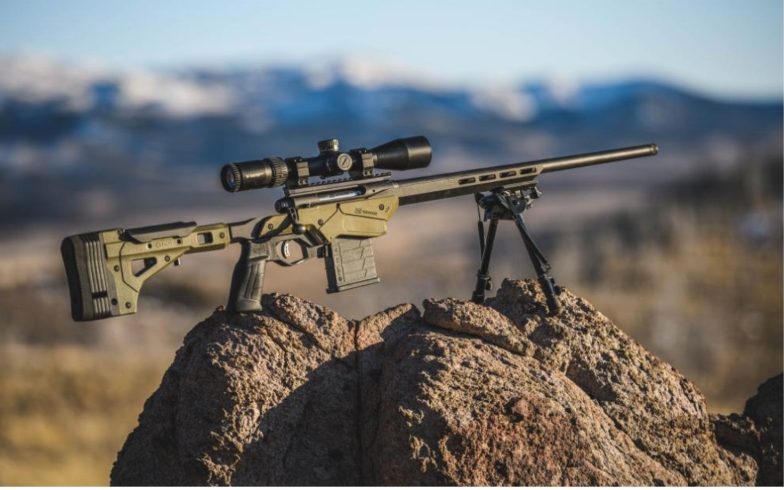
However, getting a tilted rail is not always the best solution as not all scopes are compatible to accommodate them.
In this guide, I explain what a 20 MOA scope base is and what it does to help you determine if you need one. If you do need a canted rail, I go over the benefits and the possible consequences associated with it. Depending on your same scope and cartridge, you might not need one at all!
What is a 20 MOA Rail?
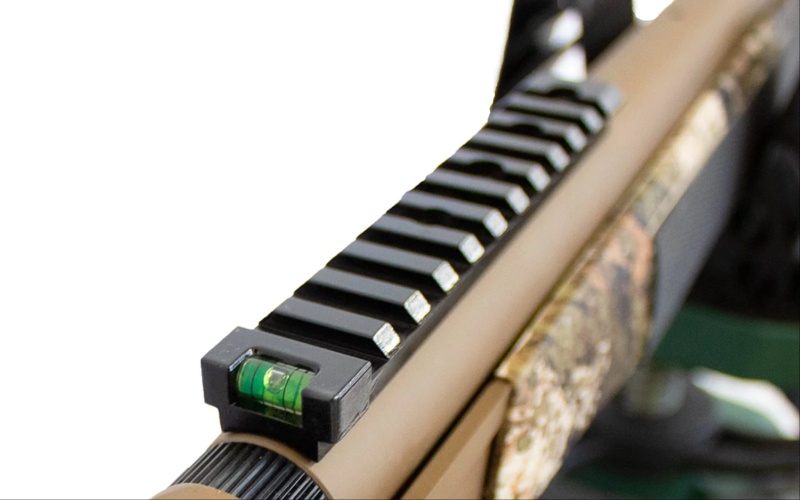
A 20 MOA rail is an inclined mounting base that allows access to more of the adjustment range available in a riflescope. Mounted and leveled correctly, a scope’s zero requires a minimal amount of adjustment from the mechanical center, but if shooting long-range is the goal, an inclined base is needed.
In an impossibly perfect riflescope, the zero would be at the exact mechanical center of the turret system inside the erector tube. It never is. It always requires some amount of adjustment to zero a riflescope out of the box.
Types of 20 MOA Bases & Mounts
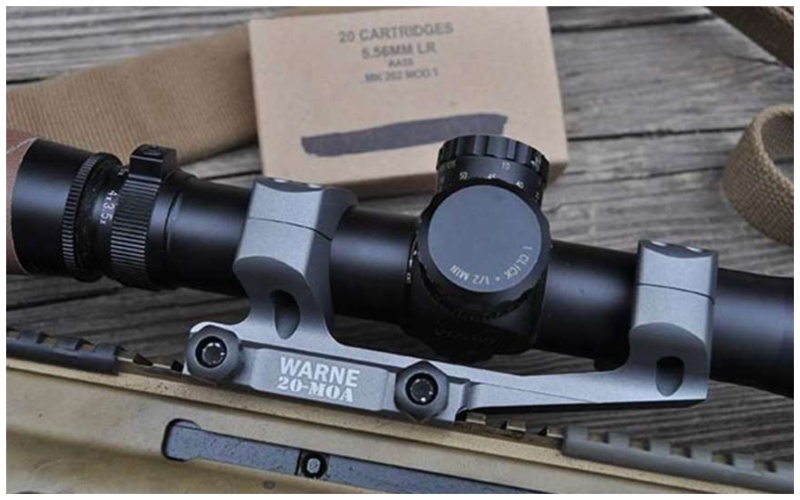
There are various types of inclined bases from rails to mounts and rings. Some have quick detach benefits while others have customizable benefits to angle a riflescope just so. Though 20 MOA bases are popular, there are other cants available, and some can be custom made to fit the need.
| Product | Type | Cant/Angle | Price Range |
|---|---|---|---|
| Monstrum for Marlin 336 | Rail | 20 MOA | Under $15 |
| UTG Leapers Super Slim Mount | Rail | 20 MOA | Under $20 |
| Monstrum Extended Series Offset Mount | Cantilever | 0/20/30 MOA | Under $30 |
| EGW for Remington 700 | Rail | 20 MOA | Under $40 |
| Burris XTR Signature Rings | Rings | 5, 10, 15, 20, 25, 30, 40 MOA inserts | Under $100 |
| Leupold Backcountry Cross Slot Rings | Rings | 20 MOA | Under $100 |
| Vortex Precision Extended Mount | Cantilever | 20 MOA | Under $200 |
Though I discuss 20 MOA rails as a specific product for discussion and solutions, you can interchange ‘20 MOA’ for 10, 15, 25, 30, 40, or 50 – whichever best fits your needs.
20 MOA Rail: Benefits & Drawbacks
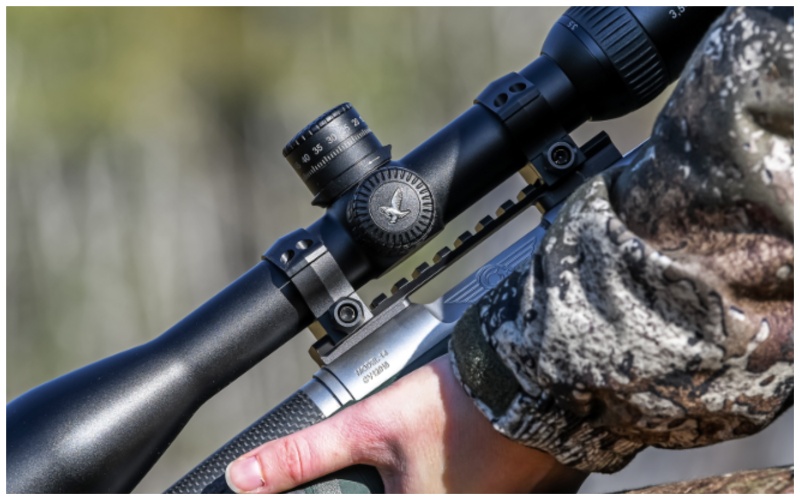
Though the primary advantage of a canted base is to use more of the available turret adjustment range, they’re not compatible for all rifle setups. There are some drawbacks that must be considered.
Pros:
- Makes use of ‘unusable’ adjustment range
- Effective for long distance shooting
- Various types of canted bases available
- Multiple ‘sizes’ of canted bases available
- Good for rifles
Cons:
- Can be hard to acquire a close-range zero
- Image quality can suffer as the erector system moves away from the optical center
- Issues can occur with the turret system at the extreme edges of the erector tube
What is MOA?
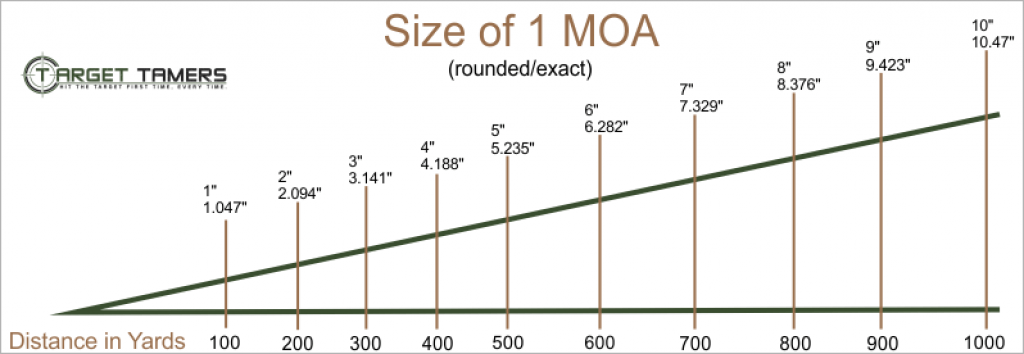
MOA stands for Minute of Angle. Due to gravity, bullet trajectory occurs in an arc, and that arc is measured in MOA. Though this is an angular measurement, it can be used to determine a linear measurement downrange. This is to predict POI behavior for all shooting disciplines.
In relation to rail mounts, a 20 MOA base has 20 ‘minutes’ of a tilt/cant. The rear end of a 20 MOA rail is thicker than the front end. It’s precisely measured to give back 20 MOA to allow more adjustment travel in a scope to shoot further.
For more in-depth information on MOA, our MOA Explained guide will get you squared away.
What is the Purpose of a 20 MOA Base?
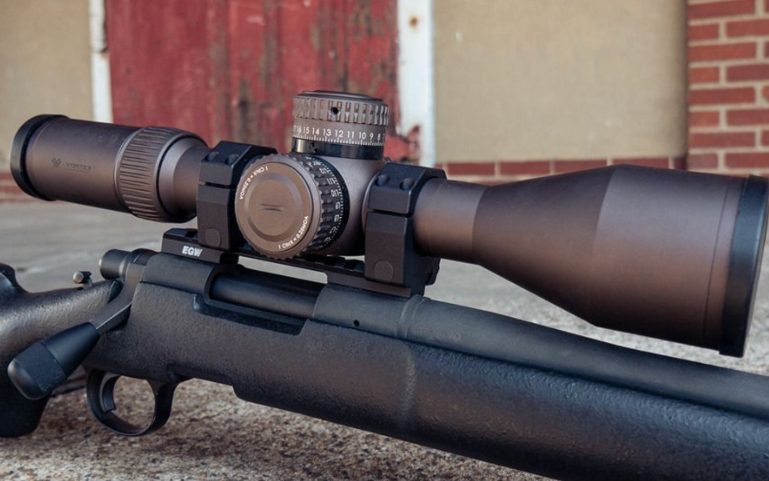
The purpose of a 20 MOA base rail is to provide back 20 minutes of adjustment into the turret travel of the scope. If it is a 10 MOA rail, it will provide back 10 minutes of adjustment into the turret travel of the scope. The amount of adjustment provided is based on the amount of cant the rail has.
Why Use a 20 MOA Rail?
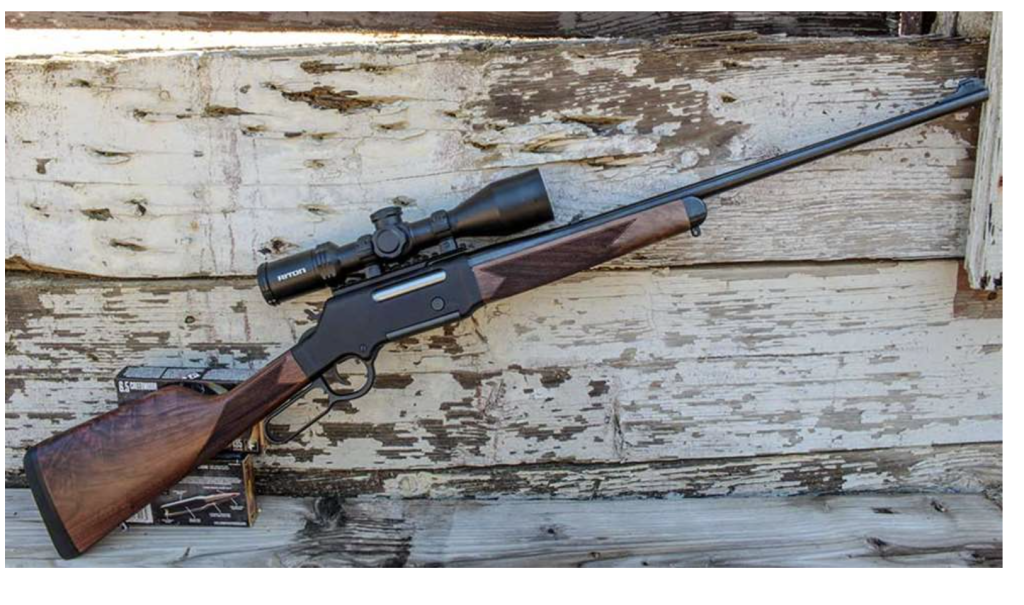
The main reason to use a 20 MOA rail, or any canted system, is to be able to use as much of a scope's adjustment range to shoot further, i.e. for long-range. Essentially, the scope is zeroed at a lower point in the total adjustment range allowing more travel in elevation to go the distance.
- Rimfire long-range shooting (200+ yards)
- Long-range shooting (500-1000 yards)
- Extreme long-range shooting (1000+ yards)
- Competition Shooting, i.e., F-Class
These are estimated distances to give you an idea as long-range can mean something different from a hunter to a precision competition shooter.
Though there are hunters that can take long shots, “long” is different depending on the target shooting and conditions. Prairie dog hunting can range from 100 to over 1000 yards. Deer is often taken inside 200 yards back East. Out West, 300 yards is a long way to go for the muzzleloader while elk can be taken at 700-800 yards or more with a skilled hunter with the right load.
For hunting, using a canted rail is not the norm for most of us. I suppose there’s always a select few where circumstances may require it. Rifle and caliber must also be considered.
How do I Know if I Need a 20 MOA Rail?
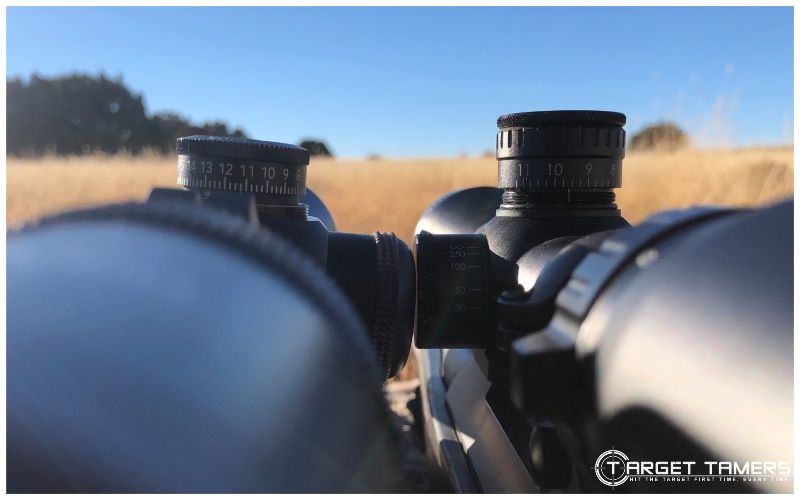
In general, a shooter will know when they’ve ran out of adjustment travel to shoot longer distances. The elevation turret cannot be physically rotated to get more adjustments. In some cases, with a 0 MOA rail, this distance may be around 500-700 yards with a 100-yard zero.
A scope with a limited amount of adjustment travel might require a canted rail just to get to longer ranges inside 1000 yards. Though a scope’s adjustment travel has a lot to do with the need for a canted rail, the rifle and cartridge must also be considered.
How to Choose a Canted Rail?
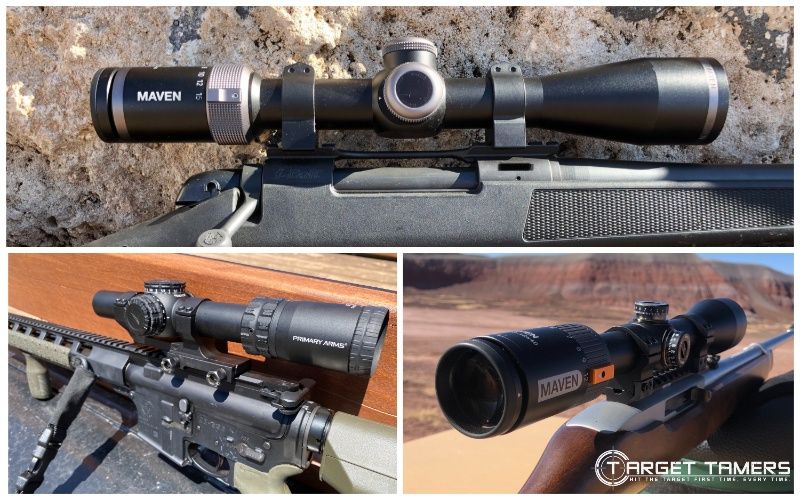
Overall, choosing the right MOA rail base depends on the total amount of turret adjustment travel the riflescope offers. It might be tempting to choose a high MOA rail but image quality, mounting height, and the zero distance must also be considered.
The best advice is to choose a canted rail with less than half of the total adjustment range available in the scope. More than this means you likely won’t be able to zero at a close-range distance like 100 yards.
Most riflescopes these days offer at least 50 MOA in total travel making a 20 MOA rail an appropriate fit. Older scopes with 40 MOA of total travel are best used with 10 or 15 MOA rails.
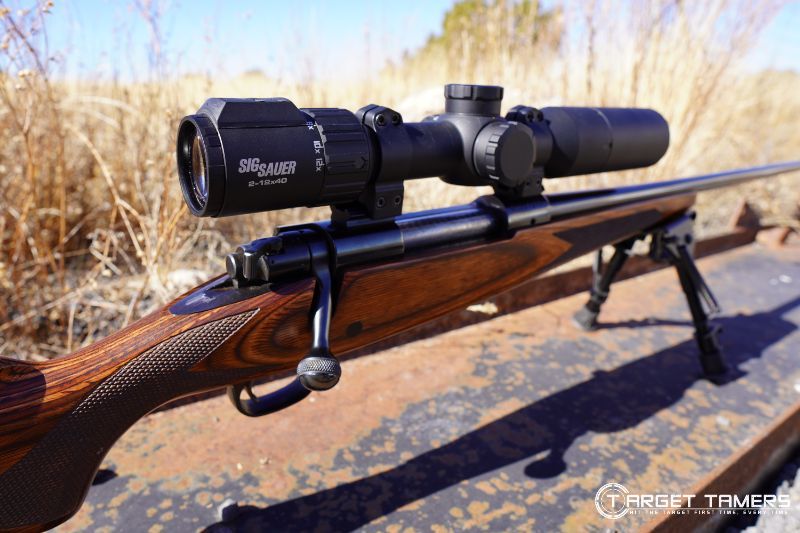
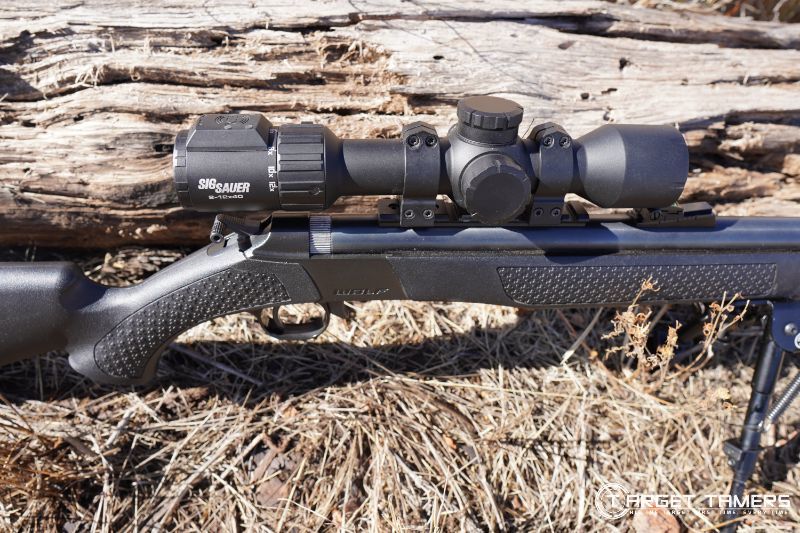
Example:
- Riflescope: Sig Sauer Sierra6 BDX 2-12x40
- Total Elevation Travel: 60 MOA
- Ballistics: 6.5 Creedmoor, 140g, 2750 fps
- Zero distance: 100 yards
- Dope: 1000 yards – 38.4 MOA
In a perfect scenario on a 0 MOA rail, the available 30 MOA in travel might get you to 875 yards. Off this flat rail, you’d run out of elevation adjustment before getting to 1000 yards.
With a 20 MOA rail shooting the same rifle and loads, you’d have 50 MOA left to dial for longer shots. That should get you close to 1150 yards.
The 20 MOA rail is providing back 20 minutes of adjustment to the total travel of the scope. Because it’s tilted, you can zero the scope at 100 yards at a much lower point in the adjustment range.
Here's how the math works:
- 60 MOA total scope travel / 2 = 30 MOA adjustments above and below the centered axis of the scope on a 0 MOA rail
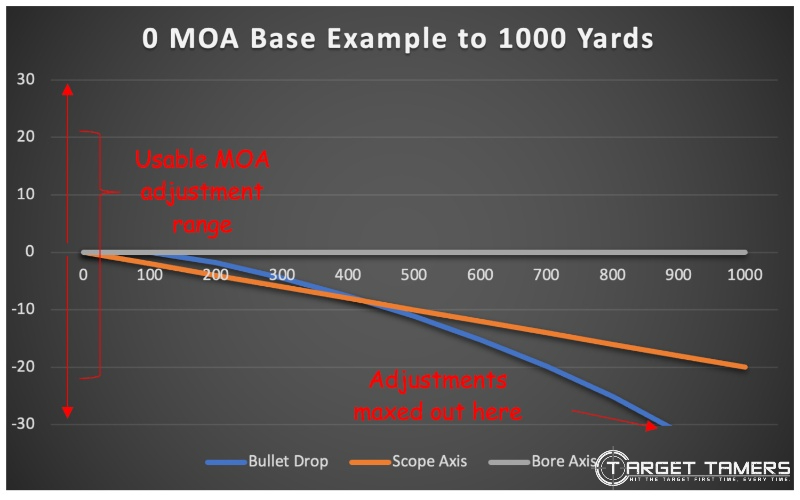
Replace the 0 MOA rail for a 20 MOA rail and the available adjustment values change:
- 30 MOA – 20 MOA = 10 MOA adjustment travel below the zero distance
- 30 MOA + 20 MOA = 50 MOA adjustment travel available to dial in for long-range shots
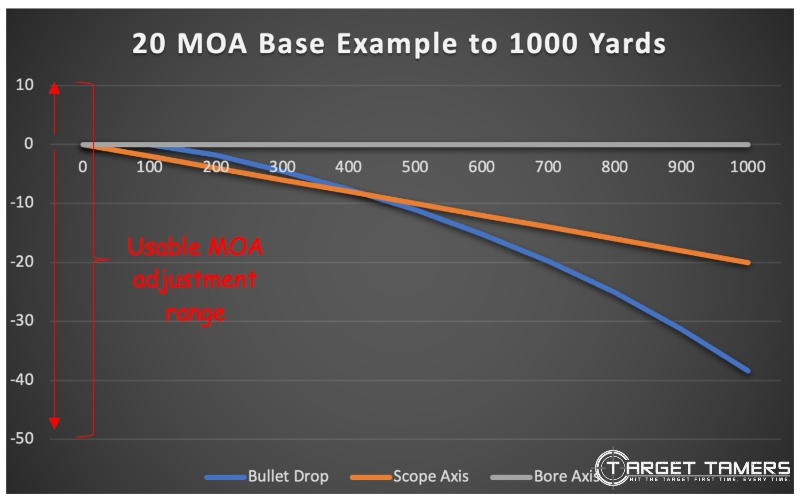
On paper, you need 38.4 MOA of adjustments to get to 1000. With 50 available MOA, you'll get there while maintaining your 100-yard zero.
Of course, it’s not going to be this neat and tidy as a scope will always require some adjustments to zero. You will lose a small amount of that to zero the scope.
0 MOA VS 20 MOA
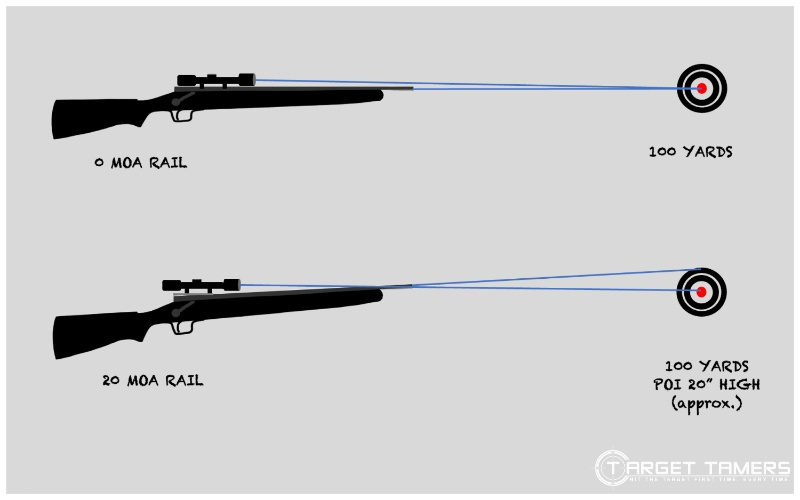
Overall, a 0 MOA base is flat and level with the bore of a rifle. It offers no additional MOA adjustment and is sufficient for many riflescopes and applications inside 500 yards. A 20 MOA base is canted where the front of the scope essentially tilts downwards towards the muzzle.
0 MOA bases are easy to use and zero with. Troubleshooting is easier, and it’s usually a non-issue to zero at 100 yards. I would say there’s enough internal scope adjustment on most riflescopes to be more forgiving of other not-so-perfect factors like mounting rings, cheek rests, and other elements that can affect scope and muzzle alignment.
A 20 MOA base, though easy to understand in concept and paper, takes some practical hands-on experience to be beneficial in actual use.
For example, at 100 yards, though the scope is centered on the bull’s-eye, the muzzle is actually pointed approximately 20” above it. To shoot now would mean the POI is 20” high. You must dial back the elevation turret to hit the bull’s-eye at 100 yards to zero.
What is Long Range?
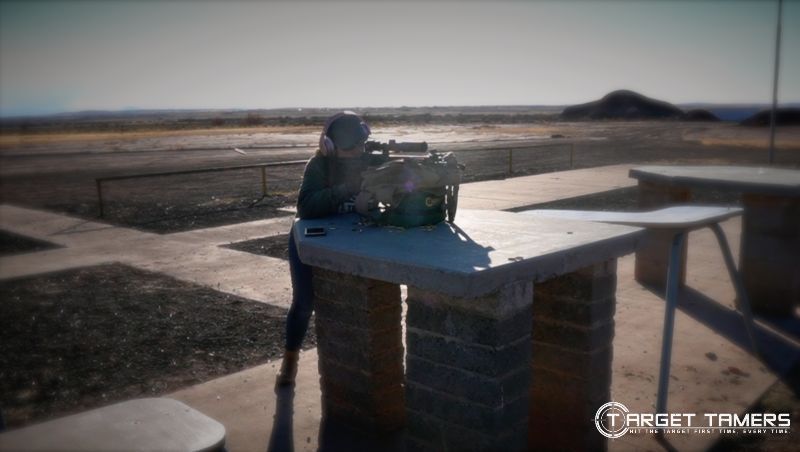
In general, long-range means something different to everyone based off the target, rifle, cartridge, conditions, and the application. 200 yards is a long way to go for the .22LR and 1000 yards is a long way to go for the .223. Yet, it’s done in competition and for shooter precision satisfaction.
Though I personally think 500 yards is a good benchmark for long-range shooting, the agreed distance is about 500-700 yards across the board. Most riflescopes these days have enough adjustment travel to get that far with a 0 MOA rail and a 100-yard zero.
However, a 20 MOA rail base is likely needed to get to 1000 yards in most cases. Total scope adjustment travel, zero stops, rifle and cartridge are all things that must be considered if you’re getting into the long-range sport.
Scope over our recommended long-range riflescopes to see if you actually just need an upgrade!
Dialing In VS BDC Reticles
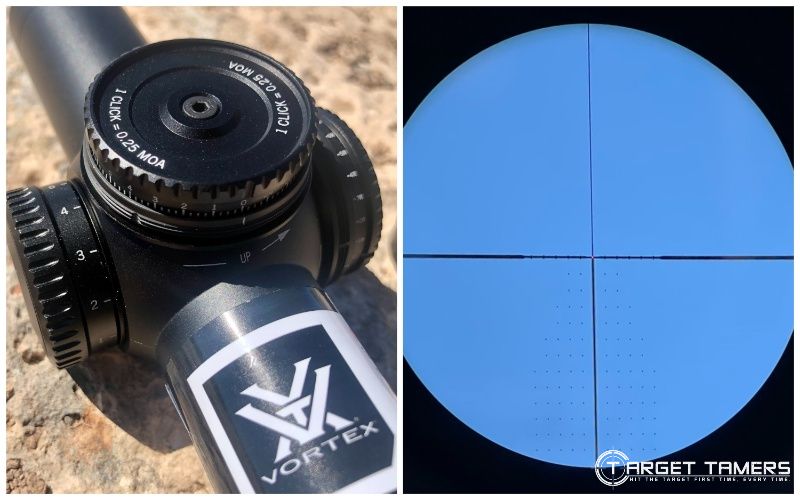
Tactical scope features are leaking into hunting scopes, and it’s not for looks. Thicker tubes, FFP reticles, and exposed turrets are trending on hunting scopes these days. Scopes that can be largely associated with combat and patrol/duty use are also efficient for big and dangerous game hunting.
Why the mix-and-mash?
Fatter tubes (30 mm+) allow for more adjustment travel. FFP reticles in FFP scopes and a parallax adjustment feature (AO or side focus) are needed for high magnification scopes especially when long-range shots are concerned.
But one of the most obvious and debatable features are exposed turrets. Seasoned hunters might say day after day that capped turrets are all they need. That’s because they’re not dialing in, they’re holding over.
Today, as more are getting into long-range shooting and with the plethora of scopes available, an exposed turret can be just as rugged and mechanically locked into position to prevent unintentional adjustments.
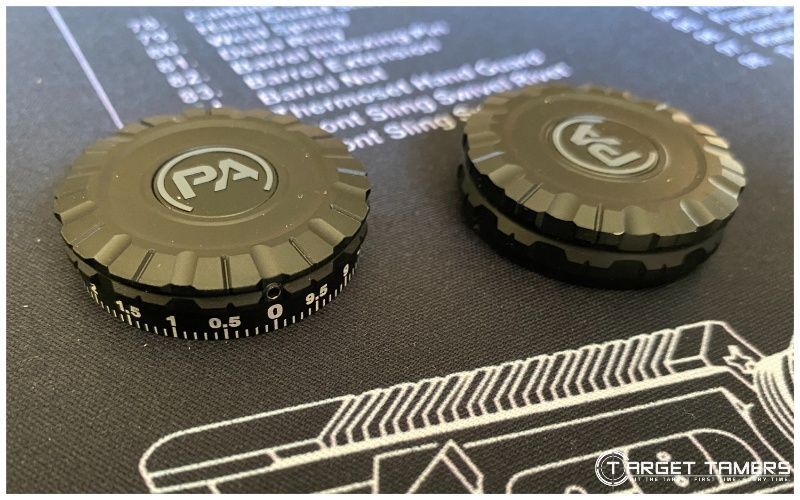
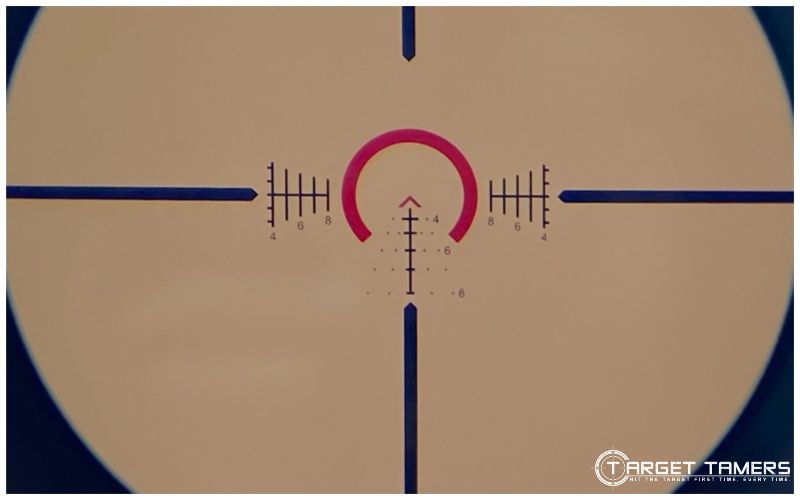
So, how does all of this relate to rails with a tilt?
Many are learning the precision skills needed for dialing in. If you’re a turret twister, a 20 MOA rail may very well help you use more the adjustment range for longer shots.
On the other hand, BDC reticles take dialing in out of the process along with the need for a 20 MOA rail. Holding over to 600, 800, 1000 yards and more can all be done with what you see on the glass.
Some scopes offer advanced characteristics that allow you to take those long shots without the shooter ever having need to guess which holdover dot or stadia you need.
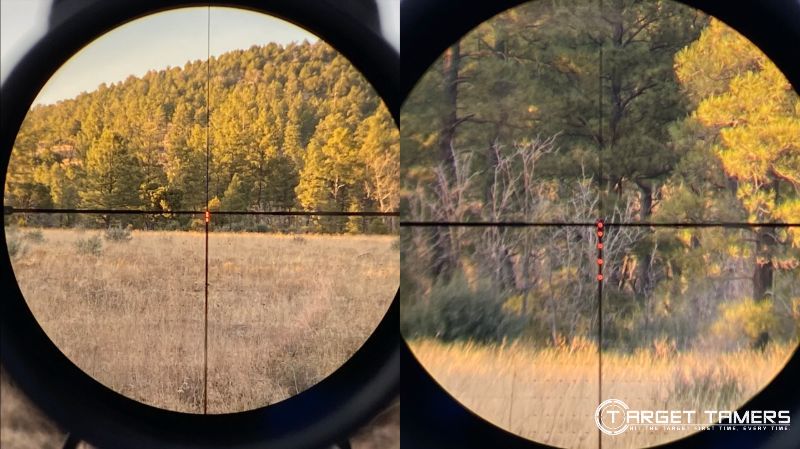
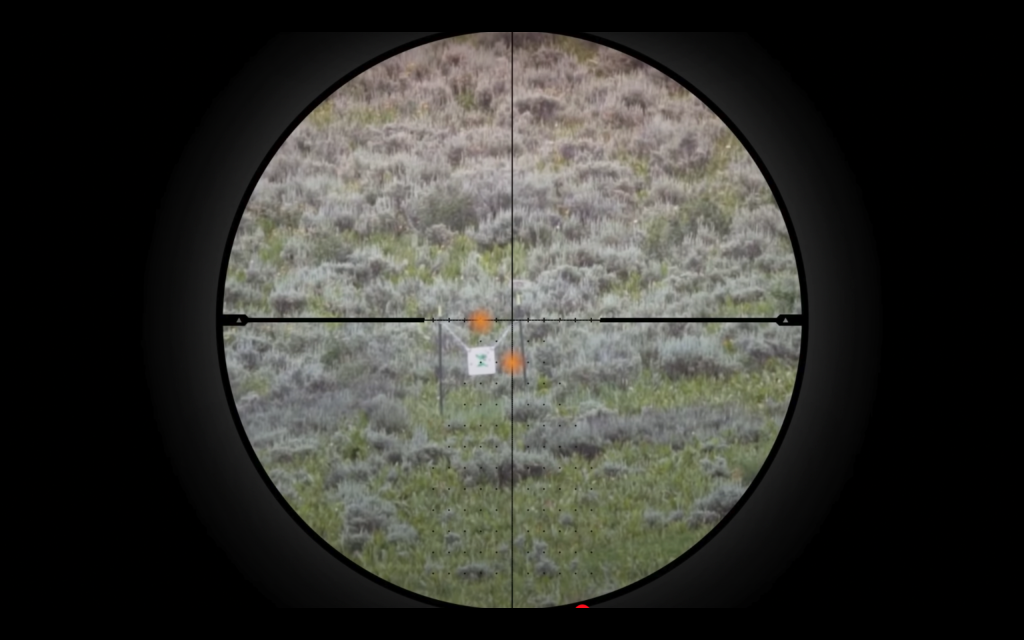
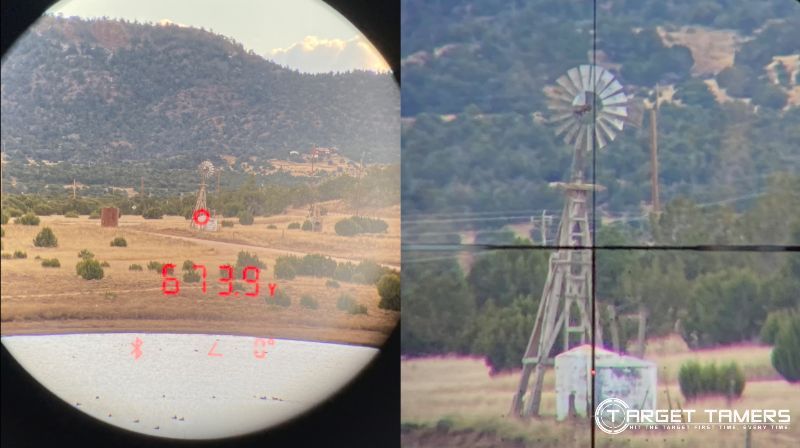
For example, Sig Sauer’s BDX app caters to custom ballistic and environmental input. Using a BDX compatible rangefinder and BDX riflescope, you can range a target and the appropriate holdover dot will be illuminated. You will need to match across for wind holdovers though.
Either way, if you’re dialing in a lot for long-range shots more than 600 yards, a 20 MOA rail will certainly get you there. You won’t need one if you’re using a BDC reticle that can go the distance.
Running Out of Adjustment: What to Do Now?
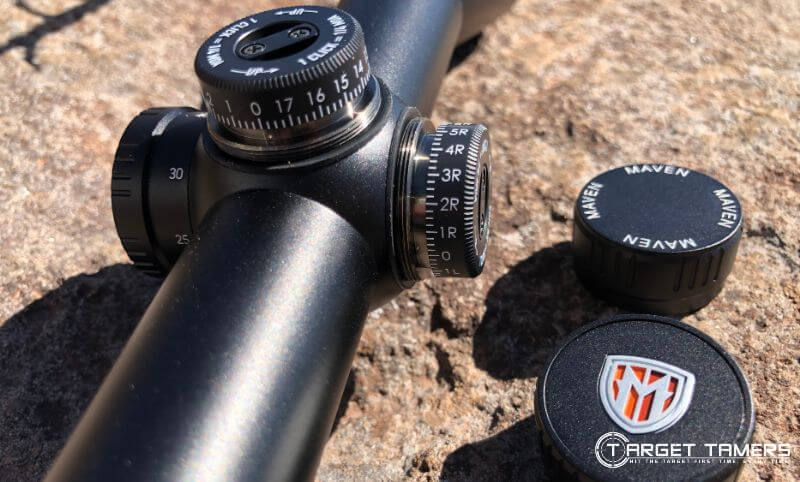
Riflescopes do not have an endless internal adjustment range. The turret system moves left/right and up/down within the erector tube to align the optical plane of the scope to the bore of the rifle. Always confirm the total adjustment range of the scope before buying.
Adjustments Have Maxed Out
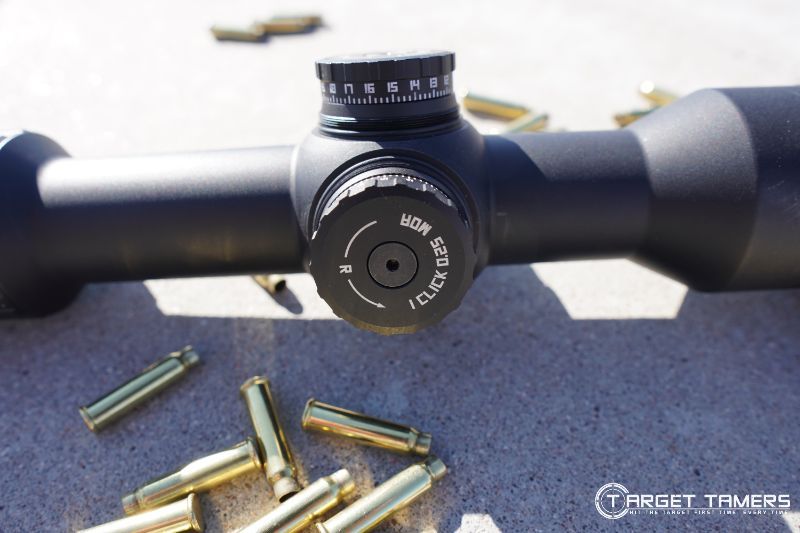
If you’re currently using a 0 MOA rail, you’re still hitting too low at distance, and you’ve maxed out on elevation adjustments, you need a raised base, i.e. a 20 MOA rail. Or you can buy a new long-range scope with more adjustment travel.
Sometimes, if you can’t acquire enough elevation to raise your POI at close range distances, like 100 or 200 yards even with a raised rail, it could be other problems. Alignment issues can be a culprit. Look to the rings or the rail as they would be the first items to troubleshoot. Disassemble and reassemble as necessary – don’t forget to bore sight!
Other times, a scope just might be defective. The best advice is to contact the manufacturer and speak to a technician to help troubleshoot or discuss warranty coverage.
Adjustments Have Bottomed Out
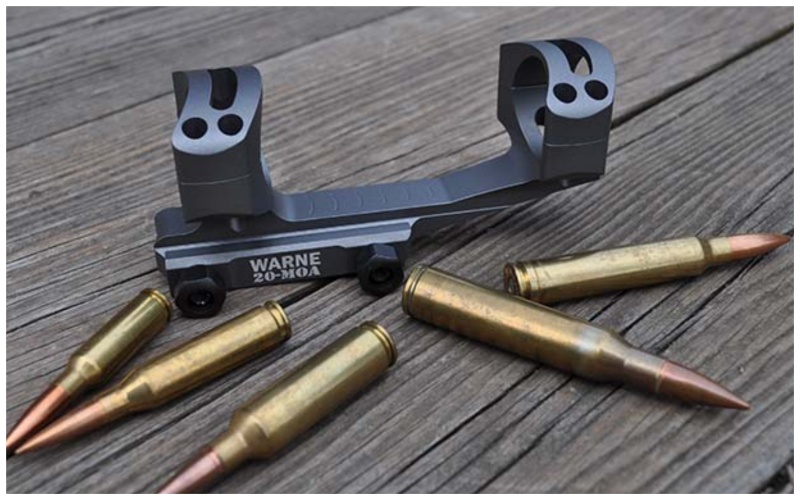
If you’ve run out of adjustments when you’re dialing down, you might already be using a base with extra MOA adjustments, or you could be hitting a zero stop.
Make sure the zero stop isn’t installed when zeroing your scope. You might think you’ve run out of adjustment travel when it’s actually the zero stop that’s preventing full travel of the adjustment range. Loosen or install the zero stop for the zeroing process. Engage the zero stop after you’ve zeroed.
If it’s not the zero stop, you may very well have bottomed out. This is common with canted rails and trying to acquire 100-yard zeros.
When you’ve bottomed out, image quality can suffer. This is because the reticle appears to move to the extremes of the FOV. This puts the aiming point off axis to the optical center of the glass. There could also be tension and pressure on the erector spring system having mechanically reached its max travel inside the tube. It also affects windage adjustments.
A fix to consider could be to use rings that allow for off-set tilts if you want to keep the inclined rail, or you can simply switch it out for a smaller canted base like a 10 MOA rail. The only option after that if you want to keep your raised rail is to zero at a different (longer) distance.
Windage Adjustments Have Maxed Out
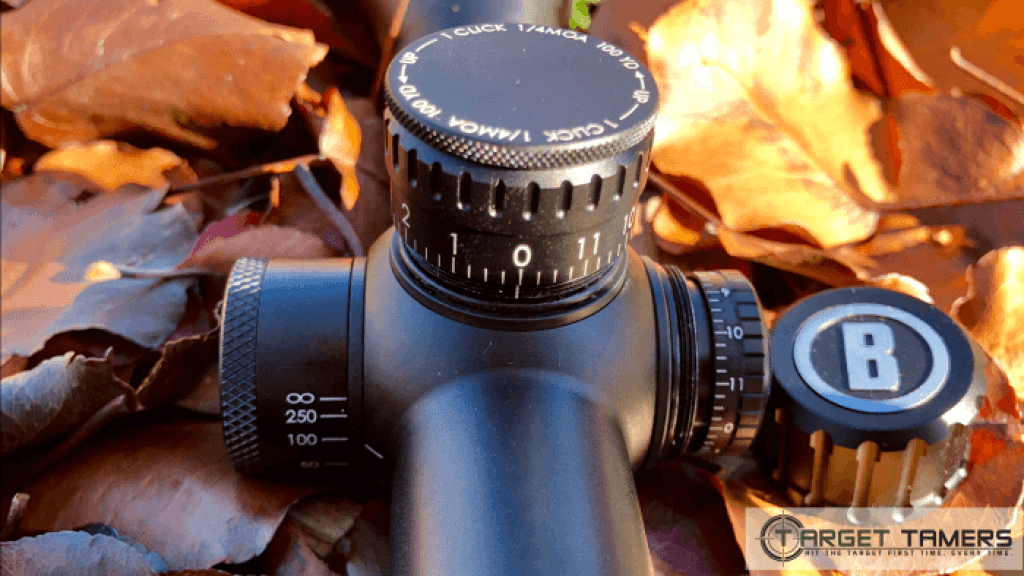
Maxing out adjustments is not unique to the elevation turret. This can happen to the windage turret too. A lot of the time, it’s the rings that are the source of the problem, but it’s always worth checking the rail if it applies. Worst case scenario, the scope is defective.
Sometimes, windage adjustments can be affected as the elevation adjustments are close to the extremes in the erector tube. Burris XTR rings can help to offset the windage problems associated with using canted rails.
FAQ's
On average, the recommended zero distance with a 20 MOA rail is 200 yards. However, acquiring a 100-yard zero can be done. The scope should have at the very least 50 MOA in total adjustment travel to zero at 100 yards with a 20 MOA rail. This is an estimate.
In general, a canted rail affects the zeroing distance and use of the turret adjustment range in a riflescope as it changes the angle of the scope to the bore. Using a 20 MOA rail and zeroing a scope will not change the relevant ballistics (DOPE).
Input sight/scope height into the calculator or app, input a new zero distance if applicable, and re-zero the scope.
Generally, a canted rail is usually intended for long-range shooting to make as much use of the available turret adjustment of a riflescope. Flat shooting cartridge are likely to do better at close range with minimal adjustment required to dial down a few MOA at 25 yards with a 100-yard zero.
This might mean having approximately 10 MOA left in adjustment to dial down depending on your setup. Typically, having a scope with more than 60 MOA total travel and a 20 MOA rail should be fine for close range shooting.
Canted bases, like the 20 MOA rail, can be used with MIL/MRAD riflescopes. Though the cant is measured in MOA, it would equate to 5.7 MILS (approx.). A simple formula to convert MOA to MILS is, MOA / (divide) 3.5 = MILS.
Do I Need a 20 MOA Base?
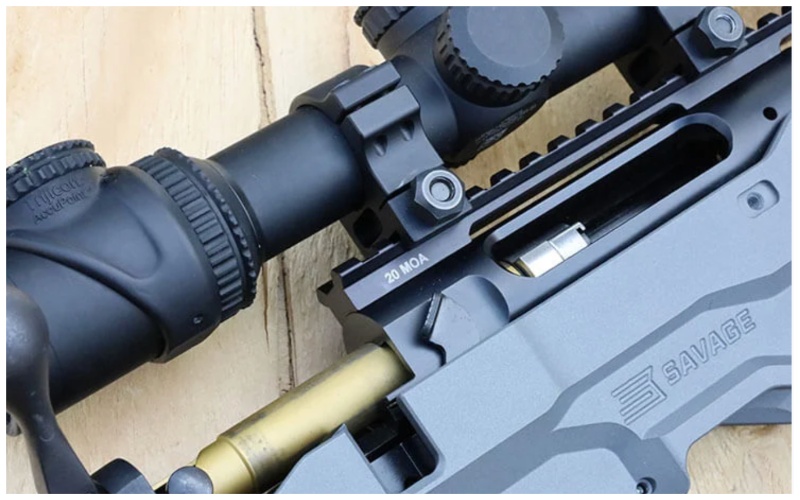
Overall, a 20 MOA rail or any other type of canted base may be needed if you don’t have enough adjustment range to go the distance. The consensus is that if you’re shooting long-range consistently, a tilted rail may be the solution to make the most of the full adjustment range.
New long-range scope versus cost for a 20 MOA rail? I think that’s an easy decision.
Short of buying a new scope with a huge amount of adjustment travel, a great benefit is that you can go further by making the most of your adjustment system with the scope you have.
Further Reading



